|
 We
took the train from Florence to Pisa as we had never seen the Leaning
Tower on previous visits to Italy. But what we found is that Pisa
has much more to see than the Leaning Tower. We
took the train from Florence to Pisa as we had never seen the Leaning
Tower on previous visits to Italy. But what we found is that Pisa
has much more to see than the Leaning Tower.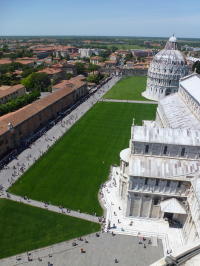 The Tower and the other sites are located about a pleasant 45 minute
walk from the train station in an area called the Field of Miracles.
For nearly 3 centuries from 1000-1300, Pisa rivaled Venice and Genoa
as a sea trading power. It used its immense wealth to build the
grand monuments of the Field of Miracles. What an amazing sight
as we approached the area and saw the huge white marble buildings
on an expanse of green lawn. In addition to the famous Leaning Tower,
the area contains the impressive Duomo and Baptistry. The buildings
are all constructed from bright white marble in a style called Pisan
Romanesque which is lighter and more elegant than traditional Romanesque.
The Tower and the other sites are located about a pleasant 45 minute
walk from the train station in an area called the Field of Miracles.
For nearly 3 centuries from 1000-1300, Pisa rivaled Venice and Genoa
as a sea trading power. It used its immense wealth to build the
grand monuments of the Field of Miracles. What an amazing sight
as we approached the area and saw the huge white marble buildings
on an expanse of green lawn. In addition to the famous Leaning Tower,
the area contains the impressive Duomo and Baptistry. The buildings
are all constructed from bright white marble in a style called Pisan
Romanesque which is lighter and more elegant than traditional Romanesque.
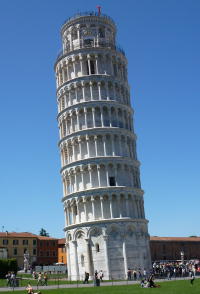 Unlike
our experience with the crowds at St. Peter's in Rome, Pisa has
a very civilized and orderly system for reserving a time to climb
the Tower. We went directly to the ticket office and bought a combo
ticket allowing us to visit all the sites and climb the Tower. Every
30 minutes, 40 people are allowed to make the climb. You are given
a time to meet in front of the tower and in the meantime you can
visit the other sites, souvenir stands and restaurants. Unlike
our experience with the crowds at St. Peter's in Rome, Pisa has
a very civilized and orderly system for reserving a time to climb
the Tower. We went directly to the ticket office and bought a combo
ticket allowing us to visit all the sites and climb the Tower. Every
30 minutes, 40 people are allowed to make the climb. You are given
a time to meet in front of the tower and in the meantime you can
visit the other sites, souvenir stands and restaurants.
 Our
first stop was the Camposanto Cemetery. The site has been a cemetery
since ancient times. The open air courtyard is surrounded by an
arcade with intricately carved arches. The courtyard's grass grows
on special dirt shipped here by returning Crusaders from Jerusalem's
Mount Calvary where Christ was crucified. It is said to turn a body
into bones in a single day! Displayed in the arcade are dozens of
ancient Roman sarcophagi. Our
first stop was the Camposanto Cemetery. The site has been a cemetery
since ancient times. The open air courtyard is surrounded by an
arcade with intricately carved arches. The courtyard's grass grows
on special dirt shipped here by returning Crusaders from Jerusalem's
Mount Calvary where Christ was crucified. It is said to turn a body
into bones in a single day! Displayed in the arcade are dozens of
ancient Roman sarcophagi. The brick walls are covered with traces of fresco.
The brick walls are covered with traces of fresco.
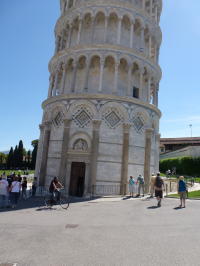 At
our appointed time, we made our way over to the Tower and climbed
the 294 tilting stairs to the top. The Tower is nearly 200 feet
tall and 55 feet wide. It is currently leaning at a five degree
angle (15 feet off the vertical axis.) after years of work to stabilize
it. The Tower started to lean almost immediately after construction
began in 1173. It was built over two centuries by at least three
different architects. Each tried to correct the leaning problem,
once at the fourth story and once at the belfry on top. At
our appointed time, we made our way over to the Tower and climbed
the 294 tilting stairs to the top. The Tower is nearly 200 feet
tall and 55 feet wide. It is currently leaning at a five degree
angle (15 feet off the vertical axis.) after years of work to stabilize
it. The Tower started to lean almost immediately after construction
began in 1173. It was built over two centuries by at least three
different architects. Each tried to correct the leaning problem,
once at the fourth story and once at the belfry on top. To
climb to the top of the Tower, you wind your way up along a spiraling
staircase that has been worn by previous tourists! Due to the slant
of the tower, the steps are also slanted and the marble can be slippery.
It was interesting to look down the center of the tower to view
the construction. And of course there was a great view from the
top. To
climb to the top of the Tower, you wind your way up along a spiraling
staircase that has been worn by previous tourists! Due to the slant
of the tower, the steps are also slanted and the marble can be slippery.
It was interesting to look down the center of the tower to view
the construction. And of course there was a great view from the
top.
After our climb we decided to visit the Baptistry. Pisa's Baptistry
is Italy's biggest. It is 180 feet tall and also leans (about 6
feet). The building was begun in 1153. It was actually built in
three sections - the Romanesque blind arches at the base in 1153,
the ornate Gothic spires and pointed arches in the middle in 1250
and the Renaissance dome in the 15th century.  In the center of the Baptistry is a huge hexagon shaped font (large
enough for baptizing adults by immersion) and an ornate pulpit carved
by Nicola Pisano. The acoustics inside the Baptistry are so good
that sound echoes for a good 10 seconds.
In the center of the Baptistry is a huge hexagon shaped font (large
enough for baptizing adults by immersion) and an ornate pulpit carved
by Nicola Pisano. The acoustics inside the Baptistry are so good
that sound echoes for a good 10 seconds.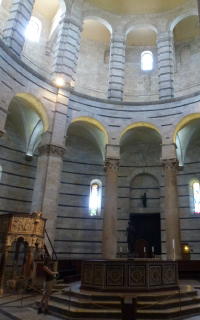 This is due to the 250 foot wide dome. It is said that a priest
standing at the baptismal font can sing three tones within the 10
seconds and make a chord, thus harmonizing with himself.
This is due to the 250 foot wide dome. It is said that a priest
standing at the baptismal font can sing three tones within the 10
seconds and make a chord, thus harmonizing with himself.
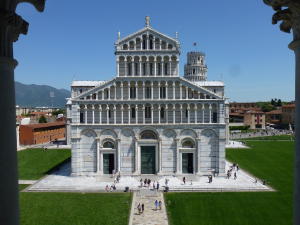 Our
last stop was a visit to the Duomo This huge Romanesque cathedral
is artistically more important than its more famous bell tower.
It was begun in 1063. The 320 foot nave of the Duomo was the longest
in Christendom when it was built. The Pulpit was carved out of white
Carrara marble by Giovanni Pisano (son of Nicola) between 1301 and
1311. It was the last, biggest and most complex of the four pulpits
by the Pisano father and son team. 400 intricately sculpted figures
smother the pulpit. Our
last stop was a visit to the Duomo This huge Romanesque cathedral
is artistically more important than its more famous bell tower.
It was begun in 1063. The 320 foot nave of the Duomo was the longest
in Christendom when it was built. The Pulpit was carved out of white
Carrara marble by Giovanni Pisano (son of Nicola) between 1301 and
1311. It was the last, biggest and most complex of the four pulpits
by the Pisano father and son team. 400 intricately sculpted figures
smother the pulpit. 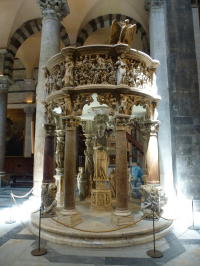 The
relief panels are actually curved and tell the story of Christ's
life. Hanging from one of the altars is a lamp that caught teenage
Galileo's attention one day in church. Someone left a door open
and a gust of wind set the lamp swinging. The
relief panels are actually curved and tell the story of Christ's
life. Hanging from one of the altars is a lamp that caught teenage
Galileo's attention one day in church. Someone left a door open
and a gust of wind set the lamp swinging. 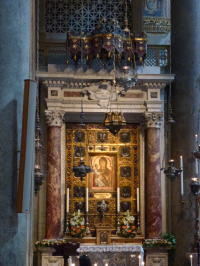 Galileo
timed the swings and realized the burner swung back and forth in
the same amount of time regardless of how wide the arc. Galileo
timed the swings and realized the burner swung back and forth in
the same amount of time regardless of how wide the arc.
Several people had told us not to bother going to Pisa but we were
so glad we did. It was one of the most enjoyable and interesting
days of our trip! From Pisa, we took the train back to Rome for
a final day of sightseeing and then the long flight home.
To view more photos from Pisa, please go to the Pisa
Photo Gallery.
Home
Locations Visited Photos Map
Contact Us
|
